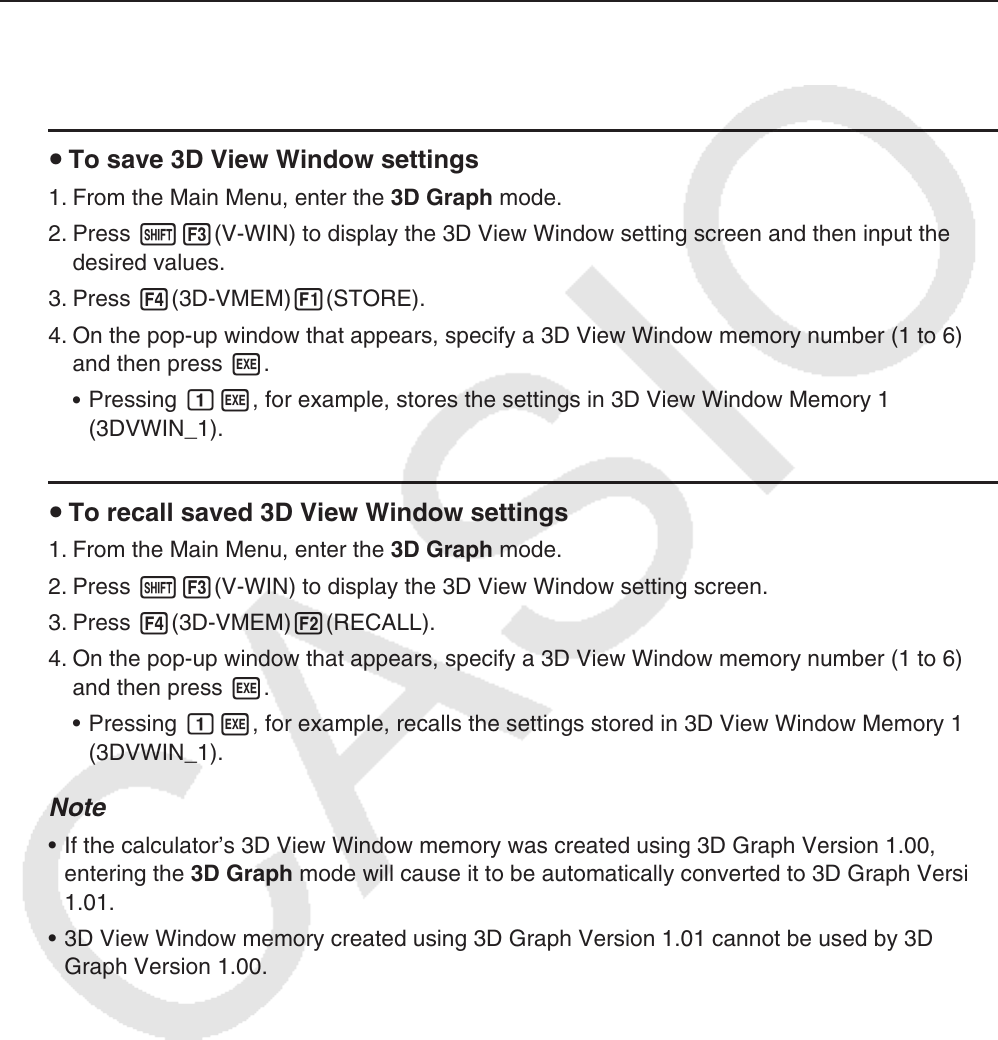User Manual
Table Of Contents
- Contents
- Getting Acquainted — Read This First!
- Chapter 1 Basic Operation
- Chapter 2 Manual Calculations
- 1. Basic Calculations
- 2. Special Functions
- 3. Specifying the Angle Unit and Display Format
- 4. Function Calculations
- 5. Numerical Calculations
- 6. Complex Number Calculations
- 7. Binary, Octal, Decimal, and Hexadecimal Calculations with Integers
- 8. Matrix Calculations
- 9. Vector Calculations
- 10. Metric Conversion Calculations
- Chapter 3 List Function
- Chapter 4 Equation Calculations
- Chapter 5 Graphing
- 1. Sample Graphs
- 2. Controlling What Appears on a Graph Screen
- 3. Drawing a Graph
- 4. Saving and Recalling Graph Screen Contents
- 5. Drawing Two Graphs on the Same Screen
- 6. Manual Graphing
- 7. Using Tables
- 8. Modifying a Graph
- 9. Dynamic Graphing
- 10. Graphing a Recursion Formula
- 11. Graphing a Conic Section
- 12. Drawing Dots, Lines, and Text on the Graph Screen (Sketch)
- 13. Function Analysis
- Chapter 6 Statistical Graphs and Calculations
- 1. Before Performing Statistical Calculations
- 2. Calculating and Graphing Single-Variable Statistical Data
- 3. Calculating and Graphing Paired-Variable Statistical Data (Curve Fitting)
- 4. Performing Statistical Calculations
- 5. Tests
- 6. Confidence Interval
- 7. Distribution
- 8. Input and Output Terms of Tests, Confidence Interval, and Distribution
- 9. Statistic Formula
- Chapter 7 Financial Calculation
- Chapter 8 Programming
- Chapter 9 Spreadsheet
- Chapter 10 eActivity
- Chapter 11 Memory Manager
- Chapter 12 System Manager
- Chapter 13 Data Communication
- Chapter 14 Geometry
- Chapter 15 Picture Plot
- Chapter 16 3D Graph Function
- Appendix
- Examination Mode
- E-CON4 Application (English)
- 1. E-CON4 Mode Overview
- 2. Sampling Screen
- 3. Auto Sensor Detection (CLAB Only)
- 4. Selecting a Sensor
- 5. Configuring the Sampling Setup
- 6. Performing Auto Sensor Calibration and Zero Adjustment
- 7. Using a Custom Probe
- 8. Using Setup Memory
- 9. Starting a Sampling Operation
- 10. Using Sample Data Memory
- 11. Using the Graph Analysis Tools to Graph Data
- 12. Graph Analysis Tool Graph Screen Operations
- 13. Calling E-CON4 Functions from an eActivity

16-5
Graphing may be impossible if the Xgrid and Ygrid values are too small.
Depending on the form of the 3D graph being drawn, Xgrid and Ygrid may be the number
of divisions of the graph itself rather than the number drawing range divisions.
Smin, Smax, Sgrid, Tmin, Tmax, and Tgrid are applied in the case of parametric graph
drawing only.
Using 3D View Window Memory
You can store up to six sets of 3D View Window settings in 3D View Window memory.
To save 3D View Window settings
1. From the Main Menu, enter the 3D Graph mode.
2. Press !3(V-WIN) to display the 3D View Window setting screen and then input the
desired values.
3. Press 4(3D-VMEM)1(STORE).
4. On the pop-up window that appears, specify a 3D View Window memory number (1 to 6)
and then press w.
Pressing bw, for example, stores the settings in 3D View Window Memory 1
(
3DVWIN_1).
To recall saved 3D View Window settings
1. From the Main Menu, enter the 3D Graph mode.
2. Press !3(V-WIN) to display the 3D View Window setting screen.
3. Press 4(3D-VMEM)2(RECALL).
4. On the pop-up window that appears, specify a 3D View Window memory number (1 to 6)
and then press w.
Pressing bw, for example, recalls the settings stored in 3D View Window Memory 1
(
3DVWIN_1).
Note
If the calculator’s 3D View Window memory was created using 3D Graph Version 1.00,
entering the 3D Graph mode will cause it to be automatically converted to 3D Graph Version
1.01.
3D View Window memory created using 3D Graph Version 1.01 cannot be used by 3D
Graph Version 1.00.
•
•
•
k
u
•
u
•
•
•










